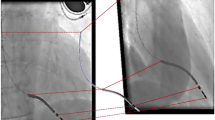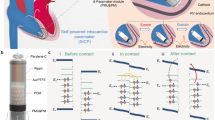Abstract
Cardiac pacing is a medical device to help human to overcome arrhythmia and to recover the regular beats of heart. A helical configuration of electrode tip is a new type of cardiac pacing lead distal tip. The helical electrode attaches itself to the desired site of heart by screwing its helical tip into the myocardium. In vivo experiments on anesthetized dogs were carried out to measure the acute interactions between helical electrode and myocardium during screw-in and pull-out processes. These data would be helpful for electrode tip design and electrode/myocardium adherence safety evaluation. They also provide reliability data for clinical site choice of human heart to implant and to fix the pacing lead. A special design of the helical tip using strain gauges is instrumented for the measurement of the screw-in and pull-out forces. We obtained the data of screw-in torques and pull-out forces for five different types of helical electrodes at nine designed sites on ten canine hearts. The results indicate that the screw-in torques increased steplike while the torque–time curves presente saw-tooth fashion. The maximum torque has a range of 0.3–1.9 N mm. Obvious differences are observed for different types of helical tips and for different test sites. Large pull-out forces are frequently obtained at epicardium of left ventricle and right ventricle lateral wall, and the forces obtained at right ventricle apex and outflow tract of right ventricle are normally small. The differences in pull-out forces are dictated by the geometrical configuration of helix and regional structures of heart muscle.
Similar content being viewed by others
References
Furman M.D. (2005). The early history of cardiac pacing. PACE 26: 2023–2032
Li B.Y. (2006). Artificial cardiac pacemaker (in Chinese). Beijing Biomed. Eng. 25(4): 445–446
Zhao, Y.: Challenges in modeling implantable medical devices. In: Proceeding of ABAQUS user conference, pp. 641–654 (2001)
Mond H.G. and Grenz D. (2004). Implantable transvenous pacing leads the shape of things to come. PACE 27: 887–893
Baxter W.W. and McCulloch A.D. (2001). In vivo finite element model-based image analysis of pacemaker lead mechanics. Med. Image Anal. 5: 255–270
Author information
Authors and Affiliations
Corresponding author
Rights and permissions
About this article
Cite this article
Zhang, X., Ma, N., Fan, H. et al. In vivo mechanical study of helical cardiac pacing electrode interacting with canine myocardium. Acta Mech Sin 23, 275–280 (2007). https://doi.org/10.1007/s10409-007-0076-3
Received:
Revised:
Accepted:
Published:
Issue Date:
DOI: https://doi.org/10.1007/s10409-007-0076-3




